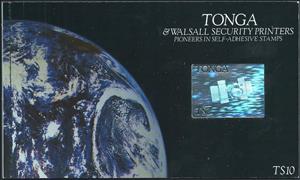Booklet: 25th Anniversary of the Introduction of Self-Adhesive Stamps (Tonga 1994)
25th Anniversary of the Introduction of Self-Adhesive Stamps (Tonga 1994)
14 December (Tonga ) within release 25th anniversary of Tongan self adhesive stamps goes into circulation Booklet 25th Anniversary of the Introduction of Self-Adhesive Stamps face value 10 Tongan pa'anga
| Booklet 25th Anniversary of the Introduction of Self-Adhesive Stamps in catalogues | |
|---|---|
| Michel: | Mi: TO 1340-1348 |
| Stamp Number: | Sn: TO 870 |
| Stanley Gibbons: | Sg: TO SB4 |
Booklet is square format.
Also in the issue 25th anniversary of Tongan self adhesive stamps:
- Booklet - 25th Anniversary of the Introduction of Self-Adhesive Stamps face value 10;
- Stamp - 75 years Rotary International: South Pacific Scout meeting face value 60;
- Booklet Pane - 75th Ann. Girl Guides - Life & Times of the Queen Mother face value 9*45;
- Stamp - Banana (Muca sp.) face value 10;
- Stamp - Queen Elizabeth Bowes-Lyon at age 10 face value 45;
- Stamp - Queen Elizabeth Bowes-Lyon at Girl Guides rally, 1931 face value 45;
- Stamp - Queen Elizabeth Bowes-Lyon in Girl Guide uniform face value 45;
- Stamp - Queen Elizabeth Bowes-Lyon, portrait by Norman Parkinson face value 45;
- Stamp - Red Shining-Parrot (Prosopeia tabuensis) face value 25;
- Booklet Pane - The Early Development of Self-Adhesive Definitives face value 195;
- Booklet Pane - The Era of Freedom Self-Adhesives face value 200;
- Booklet Pane - The Tongastar-1 Hologram face value 2;
- Stamp - Tongastar 1 face value 2;
Booklet 25th Anniversary of the Introduction of Self-Adhesive Stamps it reflects the thematic directions:
An anniversary is the date on which an event took place or an institution was founded in a previous year, and may also refer to the commemoration or celebration of that event. For example, the first event is the initial occurrence or, if planned, the inaugural of the event. One year later would be the first anniversary of that event. The word was first used for Catholic feasts to commemorate saints. Most countries celebrate national anniversaries, typically called national days. These could be the date of independence of the nation or the adoption of a new constitution or form of government. The important dates in a sitting monarch's reign may also be commemorated, an event often referred to as a "Jubilee".
A globe is a spherical model of Earth, of some other celestial body, or of the celestial sphere. Globes serve purposes similar to maps, but, unlike maps, they do not distort the surface that they portray except to scale it down. A model globe of Earth is called a terrestrial globe. A model globe of the celestial sphere is called a celestial globe
Holography is a technique that enables a wavefront to be recorded and later reconstructed. It is best known as a method of generating three-dimensional images, and has a wide range of other uses, including data storage, microscopy, and interferometry. In principle, it is possible to make a hologram for any type of wave.
A satellite or artificial satellite is an object, typically a spacecraft, placed into orbit around a celestial body. They have a variety of uses, including communication relay, weather forecasting, navigation (GPS), broadcasting, scientific research, and Earth observation. Additional military uses are reconnaissance, early warning, signals intelligence and, potentially, weapon delivery. Other satellites include the final rocket stages that place satellites in orbit and formerly useful satellites that later become defunct.




